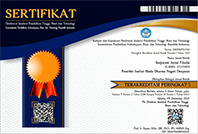MANIFESTASI TUHAN PADA TUBUH MANUSIA DALAM TEKS ANGGASTYA PRANA
DOI:
https://doi.org/10.25078/sanjiwani.v9i2.2092Kata Kunci:
God; Man; Anggastya PranaAbstrak
The human body in the concept of Hinduism consists of three layers called Tri Sarira, namely: Sthula Sarira (body), Suksma Sarira (subtle body) and Anthakarana Sarira (causative body). Stula Sarira or coarse body is the outermost layer of the human body which is formed from the Panca Maha Buta, which consists of: Pertiwi (solid element), Apah (liquid element), Bayu (air element), Teja (heat / light element), and Akasa (ether). Suksma Sarira or subtle body which is a layer of the body that cannot be seen or touched, but is present in mankind for example the mind. Anthakarana Sarira is a fine layer that is the cause of human life called Atman. Birth is closely related to the procurement of offspring, serves to pay birth debt. Debt in Sanskrit is called Rna, which developed into Tri Rna, including: debt to the Gods (Dewa Rna), debt to parents or ancestors (Pitra Rna), and debt to the Rsi (Rsi Rna). In “Lontar Anggastya prana” it is told that the life of the baby while in the womb the mother is guarded and protected by Hyang Siwa / Siwatma.
The process of creation (uttpti) begins with interest or liking at the age of adolescence until the relationship occurs / intercourse until fertilization occurs between spermatozoid (kama petak) with ovum (kama bhang) becomes Sang Hyang Antigajati in the form of the seed of life. When a child is looking for birth, he is called Sang Hyang Siwatma. When humans are born into the world, he is accompanied by four brothers called Chess Sanak in the form of Yeh Nyom (amniotic fluid), placenta, shampoo, and blood. The Catur Sanak accompanies humans from birth as Sang Anggapati, Sang Prajapati, Sang Bhanaspati, and Sang Bhanaspatiraja, until humans die and change their designation according to human development, and continue with the depiction of God in the human body in the form of sacred characters.
















